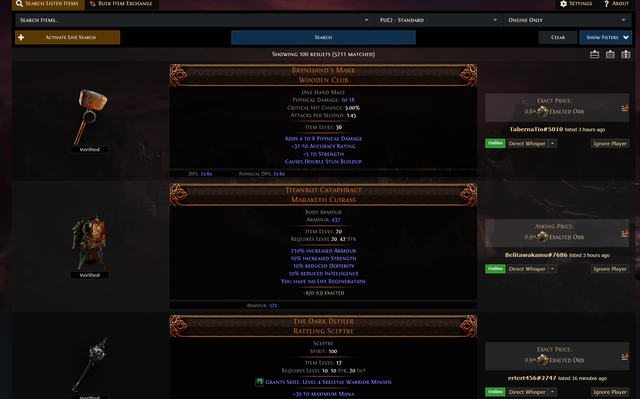PoE 2 Trade: How Trading Works in Path of Exile 2
If there’s one thing I’ve learned from years of playing Path of Exile, it’s that trading can make or break your experience. Whether you’re grinding maps, crafting gear, or flipping currency, knowing how to navigate PoE 2 trade is essential. It’s not just about making a profit—it’s about getting the best gear possible to push endgame content. So, if you’re looking to master the economy in Path of Exile 2, let’s dive into the nitty-gritty of trading.
How Trading Works in PoE 2
Unlike traditional RPGs that rely on gold, Path of Exile 2 sticks to its roots with a barter-based economy. If you’re coming from other ARPGs, this system might seem strange at first, but trust me, it becomes second nature once you get used to it. Instead of a static currency, every item has value based on demand, and currency items like Chaos Orbs and Divine Orbs act as the backbone of transactions.
Key Aspects of PoE 2 Trade:
-
No centralized marketplace, meaning you have to engage with players directly.
-
Item-for-item trading, with currency orbs serving as the medium of exchange.
-
Market-driven pricing, where the value of items constantly shifts based on league mechanics and supply.
How to Trade in PoE 2 (Without Getting Ripped Off)
Trading in PoE 2 isn’t as simple as clicking a button and getting what you want. You need to know where to look, how to price-check, and how to avoid scams. Here’s the best way to do it.
1. Use the Official PoE 2 Trade Site
If you’re serious about trading, the official Path of Exile 2 trade website should be your go-to tool. Here’s what I do:
-
Filter for the exact item I need (affixes, mods, sockets, etc.).
-
Sort listings by price and seller availability.
-
Whisper the seller directly with the auto-generated message.
Simple, right? But here’s where it gets tricky—prices fluctuate constantly. If you see a deal that looks too good to be true, grab it fast, or someone else will.
2. Player-to-Player Trading: The Old-School Way
Sometimes, I run into players in towns or hideouts who want to trade directly. While this method works, I always double-check item values before accepting a deal. Don’t be that person who overpays for a mid-tier item just because the seller hypes it up.
3. Using Third-Party Trade Tools
I won’t lie—sometimes, the official trade site isn’t enough. That’s where third-party trade tools come in. Price-checking websites and trading Discord servers can give you an edge, especially if you’re dealing in high-value items.
4. Mastering PoE 2 Currency Trading
Trading in PoE 2 currency is an art form. Chaos Orbs and Divine Orbs act as the game’s dollar bills, but when you get into high-end trading, Exalted Orbs and Mirrors of Kalandra come into play. If you’re looking to exchange currency efficiently:
-
Trade in bulk whenever possible to get better rates.
-
Watch market trends—prices spike and drop based on league mechanics.
-
Don’t fall for “quick trades” where someone offers a slightly worse deal just to move fast.
Making Profit: The Best Trade Strategies
Some players just trade to get upgrades, but others (like me) use it as a money-making strategy. If you want to make big profits in PoE 2, here are the best methods:
1. Flipping Items for Profit
Buy low, sell high—it’s the golden rule of trading. If you spot underpriced gear or currency, buy it and relist for a profit. This works best with in-demand uniques and crafting bases.
2. Crafting and Selling High-Value Gear
If you have a good eye for crafting, you can create powerful gear and sell it for a fortune. Crafted items with perfect affixes are always in demand, especially for meta builds.
3. Trading League-Specific Items
Every new league brings fresh mechanics, and smart traders take advantage. If a new boss drops an exclusive item that everyone wants, that’s your golden ticket to making currency fast.
4. Bulk Trading for Efficiency
One of my favorite tricks is bulk trading currency. Most players would rather buy 100 Chaos Orbs at once instead of making 10 separate trades, and that means you can often sell in bulk at slightly better rates.
Avoiding Common Trade Scams
I hate to say it, but scammers exist in PoE 2. If you don’t want to lose your hard-earned currency, watch out for these common scams:
-
Item Switch Scam: A player offers an item, then swaps it for a lookalike with worse stats at the last second.
-
Overpricing Scam: Some players prey on beginners by listing items way above their real value. Always double-check with the trade site.
-
Mirror Service Scam: Mirroring items is a risky business. Only use well-known crafters with a solid reputation.
The Future of PoE 2 Trade
With PoE 2 changing the game in many ways, trade might also see some updates. While Grinding Gear Games has resisted adding an auction house, I wouldn’t be surprised if they improve the trade experience in future patches. For now, though, the player-driven economy remains one of the most engaging parts of the game.
Should You Buy PoE 2 Currency?
Let’s be honest—some players just don’t have the time to grind endlessly for currency. If you’re considering buying PoE 2 currency, make sure to use a trusted source like PVPBank to avoid getting scammed. While many players prefer to grind, others use currency sellers to save time, and that’s a personal choice.
Final Thoughts
PoE 2 trade is one of the most complex yet rewarding aspects of the game. Whether you’re flipping items, crafting high-value gear, or just trying to get the best upgrades for your build, understanding how the economy works gives you a massive advantage. Learn the trade tools, watch market trends, and always be on the lookout for good deals. Trust me—mastering PoE 2 trade will make your gameplay experience so much better.

